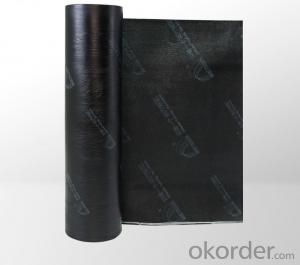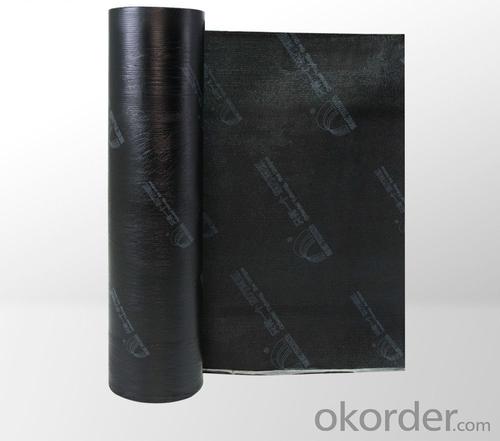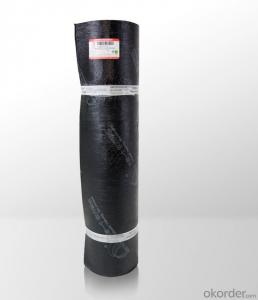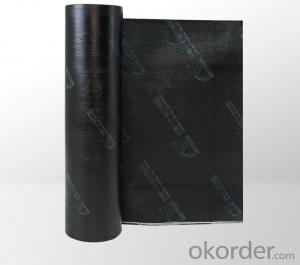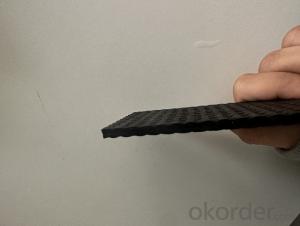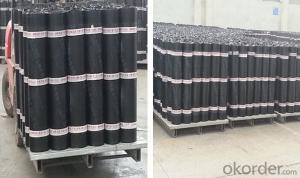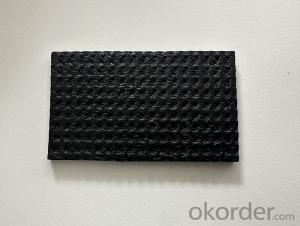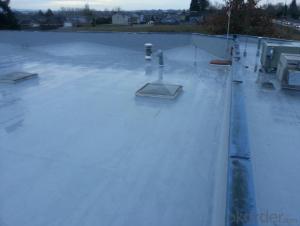PMB-742 Ultralow Temperature Elastomer (SBS) Modified Bituminous Water Proof Sheet Material
- Loading Port:
- China main port
- Payment Terms:
- TT OR LC
- Min Order Qty:
- 1000 m²
- Supply Capability:
- 500000 m²/month
OKorder Service Pledge
OKorder Financial Service
You Might Also Like
Ultralow Temperature Elastomer (SBS) Modified Bituminous Waterproof Sheet Material is a
thermoplastic and elastic modified bituminous dipping and coatingmaterial made out of Stylene-Butadiene-Stylene, it is a kind of rollable sheet water proof materials with the upper surface cover of the isolating materials like polyethylene film, fine sand or mineral slice (or particle) etc.
Type and Specification
·The physical and mechanical properties were divided in
Type Ⅰ and Type Ⅱ .
·Classified by upper surface isolating material: Polyethylene
film (PE), fine sand (S) and mineral particle (M). See below
table for detailed specifications.
Advantages
·Excellent ultralow temperature resistance performance, good
flexibility even under -40℃ , adapted to chilly region.
·The combination of filament polyester filler base and SBS
modified bitumen, forming a high strength water proof layer, to have
strong resistance agaist water pressure.
·High tensile strength, high elongation, it is adaptive to shrinkage,
deformation and fracture of base.
·Good resistance of high temperature,is able to meet the need of
various seasaons.
·High strength polyester filler base material has large thickness,
resistance of puncture, breaking, tearing and resistance of fatigue.
·Good performance of resistance to corrosion, mould and
weather.
·Good workability, we may construct by hot melt cementation
method during four seasons in the whole year, hot-joint is durable
and reliable.
Application Range
Applied in Grade Ⅰ and Grade Ⅱ water proof engineering in
various industrial and civil sections, be mostly appropriate to the
following engineering:
·Various industrial and civil construction roof and underground
water proof in chilly region.
·Indoor swimming pool and fire pool water proof of industrial and
civil construction.
·Water proof for municipal engineering such as subway, tunnel,
concrete road surface, bridge surface, sewage works and refuse
landfill etc.
·Water proof for water conservancy facilities like canal and water
pool etc .
- Q: Can a waterproofing membrane be used on stone block surfaces?
- Stone block surfaces can indeed benefit from the use of a waterproofing membrane. This particular membrane is specifically designed to create a protective barrier against water and moisture, making it suitable for application on various surfaces, including stone blocks. By acting as a barrier, this membrane effectively prevents water from seeping into the stone and causing detrimental effects such as cracking, spalling, or efflorescence. It offers valuable protection against water-related issues such as freeze-thaw damage and the growth of mold and mildew. Moreover, the application of a waterproofing membrane can significantly enhance the durability and longevity of stone blocks by shielding them from water damage. Consequently, it is highly recommended to utilize a waterproofing membrane on stone block surfaces to ensure their long-term integrity and aesthetics.
- Q: Can a waterproofing membrane be used for HVAC systems?
- No, a waterproofing membrane cannot be directly used for HVAC systems. Waterproofing membranes are designed to prevent water from penetrating through surfaces such as roofs, foundations, or walls. They are typically made of materials like bitumen, rubber, or polyurethane and are meant to protect against water damage. On the other hand, HVAC (Heating, Ventilation, and Air Conditioning) systems are responsible for regulating temperature, humidity, and air quality within a building. They consist of various components like ductwork, air handlers, and condensing units that are specifically designed for the purpose of conditioning and circulating air. While there may be some overlap in terms of protecting certain HVAC system components from moisture, such as ductwork insulation, a waterproofing membrane alone is not sufficient or appropriate for HVAC systems. HVAC systems require specialized materials and equipment that are designed to handle the specific needs and requirements of air conditioning and ventilation. Therefore, it is important to use the proper materials and equipment specifically designed for HVAC systems to ensure their efficient and effective operation.
- Q: What is the preferred level of waterproofing?
- 2, roof 2 waterproof: Applications: important buildings and high-rise buildings; Waterproof layer of reasonable use of life: 15 years; Waterproof layer selection of materials: should choose high polymer modified asphalt waterproofing membrane, synthetic polymer waterproofing membrane, metal sheet, synthetic polymer waterproof coating, high polymer modified asphalt waterproof coating, fine stone concrete, flat tile, linoleum Tile and other materials; Fortification requirements: two waterproof fortification.
- Q: Can a waterproofing membrane be used for a shower pan liner installation?
- Yes, a waterproofing membrane can be used for a shower pan liner installation. Waterproofing membranes are commonly used in shower installations to prevent water from seeping through the shower pan and causing damage to the surrounding areas. They provide an effective barrier against moisture and help to keep the shower area waterproof.
- Q: Can a waterproofing membrane be used on flat roofs?
- Flat roofs can indeed benefit from the use of a waterproofing membrane. This method is widely recognized as one of the most effective and commonly used techniques for achieving waterproofing on flat roofs. The membrane itself is a thin material that is carefully applied to the roof's surface in order to prevent any water from seeping through. Typically constructed from durable and flexible substances like synthetic rubber or modified bitumen, the membrane is designed to withstand harsh weather conditions and offer long-lasting protection. By installing the membrane in overlapping layers, a continuous barrier is created that effectively seals the roof, preventing any water leakage into the building. Additionally, it is worth noting that waterproofing membranes can also provide insulation and energy efficiency advantages, which further contributes to their popularity in flat roof applications.
- Q: Can a waterproofing membrane be used on concrete tanks?
- Yes, a waterproofing membrane can be used on concrete tanks. A waterproofing membrane is designed to provide a barrier against water penetration and can be applied to various surfaces, including concrete. Concrete tanks, such as those used for water storage or containment, can benefit from the use of a waterproofing membrane to prevent water leakage or seepage. The membrane is applied to the concrete surface, creating a protective layer that prevents water from entering or exiting the tank. This can help to maintain the structural integrity of the tank and prevent any potential damage or contamination caused by water leakage. Additionally, waterproofing membranes can also provide protection against other substances, such as chemicals or pollutants, that may be present in the tank. It is important to choose the appropriate type of membrane for the specific requirements of the concrete tank and to follow the manufacturer's instructions for application to ensure effective and long-lasting waterproofing.
- Q: Can a waterproofing membrane be applied over existing waterproofing layers?
- Yes, a waterproofing membrane can be applied over existing waterproofing layers. However, it is important to assess the condition of the existing layers to ensure they are sound and can provide a proper substrate for the new membrane. Additionally, proper surface preparation and compatibility between the existing layers and the new membrane should be considered to ensure a successful and long-lasting waterproofing system.
- Q: Can a waterproofing membrane be used for soundproofing purposes?
- No, a waterproofing membrane cannot be used for soundproofing purposes as it is specifically designed to prevent the penetration of water and does not have the necessary properties to effectively block or absorb sound waves.
- Q: Can a waterproofing membrane be used for tunnels and underground structures?
- Tunnels and underground structures necessitate the use of a waterproofing membrane to combat water infiltration and safeguard against potential water damage. Such membranes are commonly employed in construction to create a barrier against water and are particularly vital in these situations due to the increased risk of water ingress from surrounding soil and groundwater. The integrity and longevity of the infrastructure rely on waterproofing membranes in these environments. Waterproofing membranes designed for tunnels and underground structures are specifically engineered to endure the unique challenges presented by these settings. Typically composed of resilient and flexible materials like bitumen, PVC, or EPDM, they effectively resist water pressure and provide long-lasting protection. Furthermore, these membranes are often reinforced with multiple layers or fabrics to enhance strength and resistance against punctures or tears. The meticulous process of applying waterproofing membranes in tunnels and underground structures involves thorough cleaning and preparation of surfaces such as walls and floors to ensure proper adhesion of the membrane. Multiple layers are then applied to achieve complete coverage and a seamless seal. Special attention is paid to critical areas such as joints, corners, and penetrations to eliminate potential weak points. The utilization of a waterproofing membrane effectively shields tunnels and underground structures from water intrusion, groundwater pressure, and potential moisture-induced damage. This preserves the structural integrity of the infrastructure, prevents water-related issues like leaks, corrosion, or deterioration, and guarantees the safety and functionality of the tunnel or underground facility.
- Q: Can a waterproofing membrane be used for below-grade parking garages?
- For below-grade parking garages, it is highly recommended to utilize a waterproofing membrane. This is due to the fact that these structures are vulnerable to water infiltration and moisture damage. Being situated underground, below-grade parking garages are particularly susceptible to water penetration. To counteract this, a waterproofing membrane acts as a barrier to prevent water from seeping into the structure and causing harm to the concrete, reinforcing steel, and other materials. Typically, the membrane is applied to the exterior walls and floor of the parking garage, creating a seamless and watertight seal. To ensure long-term protection against water ingress, it is essential to select a high-quality and durable waterproofing membrane that is specifically designed for below-grade applications. Additionally, the proper installation of the waterproofing system by trained professionals is crucial to guarantee its effectiveness.
Send your message to us
PMB-742 Ultralow Temperature Elastomer (SBS) Modified Bituminous Water Proof Sheet Material
- Loading Port:
- China main port
- Payment Terms:
- TT OR LC
- Min Order Qty:
- 1000 m²
- Supply Capability:
- 500000 m²/month
OKorder Service Pledge
OKorder Financial Service
Similar products
Hot products
Hot Searches
Related keywords
